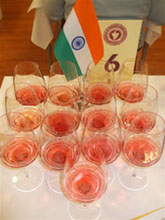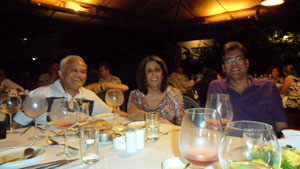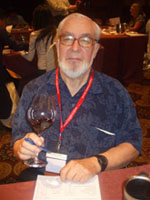Despite recent aborted efforts of European union to allow mixing of red wine with white to make the pink Rosé, the world at large still makes the undervalued wine by transforming the juice of black grapes, leaving the mixing to pink champagnes, writes John Salvi, MW from Bordeaux, peeling off varioua layers in understanding a wine that hasn’t got its share of popularity it deseres.
 Rosé, Rosado, Rosato, Pink – even Shocking Pink! What image comes to mind when one closes ones eyes and thinks of pink wine? I am sure we all see very different things, but mine is a vision of sea, sand and golden beaches, sunlit tables with lobster mayonnaise and fresh fruit salad, and in the middle of the table an ice bucket beaded with moisture and holding a fragrant bottle of rosé nestling in the ice. My loved one sits beside me and lithe, topless young maidens frolic at the edge of the water! Rosé, Rosado, Rosato, Pink – even Shocking Pink! What image comes to mind when one closes ones eyes and thinks of pink wine? I am sure we all see very different things, but mine is a vision of sea, sand and golden beaches, sunlit tables with lobster mayonnaise and fresh fruit salad, and in the middle of the table an ice bucket beaded with moisture and holding a fragrant bottle of rosé nestling in the ice. My loved one sits beside me and lithe, topless young maidens frolic at the edge of the water!
Regretfully, not only does this picture never come true, but also I am certain that it is very far from the one that serious producers of Rosé would wish me to visualise! I am a lost cause, an unpardonable philistine, but for the sake of this article I will reign in my unruly imagination and talk about Rosé with a clean and serious mind.
History-speak
Rosé is for certain the oldest wine in the world. Studies of the very oldest representations (vases, mosaics, bas-reliefs etc.) show that wine made in those ancient times could not have been anything but “clear coloured” because the grapes were pressed directly and the juice collected and fermented separately. It was not fermented with the skins and pips and therefore could not have been very red. It was a sort of grey colour and how clear it was depended on how bright it fell of its own accord.
Clear or “clairet” was in those days strictly relative. We will discuss this pragmatic and logical name further on in this article. What is interesting is that the first record, in print, of the actual use of the term “Rosé” is not until 1682 in the vineyard of Argenteuil.
Sadly, Rosé has often and long been regarded as a second class wine. As a secondary wine, made by default on the way to making red wine, without great technical complexity and unworthy of the attention of the oenologist. This is perhaps because so much of it is of very poor quality. Nonetheless this is grossly unfair on producers of fine Rosé because Rosé requires great technical skill to be perfectly balanced, beautifully coloured and wonderfully fragrant and fruity.
Please don’t mix Red and White !
Recently, producers of Rosé, especially those of serious and high quality, were petrified and horrified and indeed almost beside themselves with rage and fear, due to a proposal by the European Union to make it legal to mix red and white wine to make Rosé. This was supported by the Comité Européen des Entreprises de Vin following a report by the Organisation Mondiale du Commerce.
To producers this was the most heinous of crimes that could possibly be committed in the wine world. Did Brussels not know that great skill, art and knowledge, as well as fine judgement, was required to make fine Rosé? Indeed so violent was the opposition of growers, as well as protestations by almost everybody connected with wine, that the proposal was shelved pro-tem by Mariann Fischer Boel, the Commissioner of European Agriculture.
Red into White won’t go...
The issue will surely raise its ugly head again in the not too distant future. Had the proposal been adopted it would have put producers of Rosé out of business. Why would one go through the delicate and agonising process of making fine, delicate and aromatic Rosé if somebody just down the road from you could just tip a barrel of Red into a barrel of White, even if the quality was not a patch on the real thing?
...except in Champagne
Champagne remains the only wine in EU that may legally mix red and white grapes to make Rosé. Champagne is permitted to blend Chardonnay, Pinot Blanc and Pinot Meunier with Pinot Noir, although here it is not just a simple mixing of red and white wines after fermentation, since the blend of grapes in the vat has to undergo the “prise de mousse”, which corresponds to a new fermentation caused by the “liqueur” which is added and which creates the pressure and therefore the bubbles in the bottle.
Not only this but the wine then has to spend 9 months minimum in bottle, which modifies the structure of the wine thanks to the phenomenon of the autolysis of the yeasts. Not quite the only one as there remains the anachronistic and rare Spanish animal, the “vino tinto de mezcla”.
Sacrilegious Crime
| Photo By:: |

|
| Rosa Rossa Rose from Big Banyan at a wine dinner |
Sadly we seasoned cynics, particularly old wine writers like myself, know that this sacrilegious crime is committed far too often and totally illegally even if not so often at producer level. Indeed, my daughter spent a summer job serving in a wine shop in a nudist camp in the north of the Médoc. In this shop they served Red, White and Rosé from the barrel – bring your own container and run the wine into it from the spigot. Once a week the proprietor would arrive to see how things were going and pour bottles of cheap Red wine into the Rosé barrel. He would then add a judicious number of bottles of his cheapest White wine, testing until he obtained the colour he desired, and hey presto! Rosé of the week was ready for sale!
My son, on the other hand, did his summer job as a barman in a wine bar on the Côte D’Azur. Here, after closing time and before going home, all the bottles of Red and White wine that were more than half empty were mixed together and put into used, empty Rosé bottles to serve as the House Rosé the following day. The real problem is that such practices as those just mentioned above, although totally scandalous and outrageous, are almost impossible to stop or to control.
Colour and Flavour Profiles
One of the things that I much enjoy about Rosé is its colour and the almost infinite variety that this can encompass. It is HUGE. The colour can vary from the almost Red wine colour of, for example, the Spanish Clarete from Navarra, to the palest, lightest pink and even the Pelure d’Oignon (onion skin) or Vin Gris (grey wine), which although not strictly Rosé are counted as such officially because there is nowhere else to put them, made from the sandy soils in some parts of France.
There is an important and annual comprehensive tasting of Rosé wines from all over the world, which takes place every year in Cannes under the aegis of the French Union of Oenologists. Here the tasters sample and judge some 500 pink wines during three days. It is quite a marathon! During this time the judges are taken on a visit to the “Centre de Recherche et d’Experimentation sur le Vin Rosé”, possibly the only such institution in the world dedicated entirely to serious technical research on Rosé alone. Most of the technical information in this article comes from here. They have an immense colour chart showing the full range of the possible colours that a Rosé can have. There are no less than 143 different shades on it and I am quite sure that there are a few more that it has not encompassed.
As for the taste of Rosé, it can run almost as wide a gamut as the colour. It can vary from the muscular, full-bodied, almost red wine bodied, tannic Rosé, again from Navarra, to those ethereal, light, crisp explosions of fruit and flowers, which come and are gone in the mouth like little bursts of sherbet.
Aging of Rosé Wines- Rosé de Garde
It is this tremendous variation which provides a large part of the fascination and enjoyment of drinking Rosé wine. However, in Provence, in recent years, and also in other regions and other countries, growers have been making Rosé wines, which they advise the consumer to keep and age for several years- what they term “Rosé de Garde”. These are structured and have both body and weight as well as alcohol and even a modicum of tannin. They are regarded as “serious” Rosé.
Beach Wines- Rosé de Plage
They seem to be very much à la mode with a certain category of drinkers, especially in Provence, whilst the other end of the spectrum is termed “Rosé de Plage” or “beach Rosé”. These are the cheap end of the spectrum and made often without much care and attention or thought for quality. Frequently they are rather acidic, thin and sharp and frankly not very enjoyable.
They are made by producers who disdainfully consider that holidaymakers, sitting in their bathing costumes at beach restaurants and cafés, have no appreciation of quality and will drink anything if it is cold and iced enough. Ice the wines out of their mind, they say, and the tourist will drink it by the gallon. Regretfully they sell millions of bottles this way and are not as far wrong as they ought to be. Please give me the benefit of believing that my image of Rosé at the beginning of this article was certainly NOT one of those bottles!
Fine Rosé made in vineyards
Making fine Rosé is in fact highly technical and starts in the vineyards. It is now clearly understood that the criteria best suited to making red wine are not necessarily the same as those for making Rosé. The ratio of the amount of deleafing/kilogram of grapes is not as important. Also parcellar selection can take into account more directly the criteria of “feeble hydric stress” and of “homogenous coloration of the berries when completely ripe”; allied to the fluidity of the pulp (the pulp should not be gelatinous).
Perfect Grape for perfect wine
Perfect health of the grapes is also more important for Rosé. Both the vivacity and the stability of the colour, so vital for Rosé, are influenced by the presence or absence of enzymes produced by botrytis. The aromatic purity is vital and can be adversely affected by any earthy aromas. The efficacy and perfect carrying out of the decanting operation allows less microbiological contamination of the grapes by the indigenous micro flora, and it is important that this is done BEFORE any fermentation. This last point is particularly important, since the colour potential must be perfectly judged and varies according to the grape variety and even for the same variety depending upon its state of maturity and the conditions of the vintage. Also it will help to obtain a truly “fruity Rosé, aromatically pure and without vegetative odours.
An empirical approach to this problem is to note the number of cooler nights (lower than 15°C) in August, since the thermal amplitude day/night is favourable to the accumulation of anthocyanins in the skins of the grape. Finally the best “fruity” and “round” flavours are obtained by a pre-fermentation maceration, which allows selective extraction of certain pellicular compounds (polysaccharide aroma precursors). This maceration also favours diffusion into the must of the anthocyanins responsible for the colour of the grape and thus the wine. The winemaker must therefore find the perfect equilibrium between the desired colour for the finished wine and its taste profile (roundness, acidity, fruit, tannin, etc.).
Making of Rosé
There are in essence three methods of making Rosé, although these overlap, and also there is no sufficiently precise definition of the term “Vin Rosé” either at the French or the international level. It could be described as “the product of an alcoholic fermentation from a must obtained through a carefully controlled pre-fermentation pellicular maceration of red grapes”. Thus a maceration in an aqueous solution.
Historically, Rosé is a process of bleeding off juice. Let us take “clairet” first. This today enjoys a French appellation contrôlée in the Bordeaux area.“Bordeaux Clairet” was created by the official decree of 21st January 1950, modified by the decree of 1st September 1977.
It is the Cave de Quinsac who claims to have re-launched clairet, which was popular in England during the three centuries that Aquitaine was under English rule.
Absolutely strictly speaking it is a very light coloured red wine with very little tannin, supple, fruity and excellent drunk young and fresh. It is best obtained with fully ripe grapes, which are macerated in their juice for some 24-36 hours depending on the intensity of the colour of the grapes. The juice is then run off and fermented separately. This is sometimes known as “saignée” or “bleeding”.
Obtaining the perfect colour at the moment of running off the juice is a delicate art, as is achieving the perfect balance of fruit and freshness. The first juice that comes out of the grapes in a fermenting vat is always the sweetest, most of the sugar being still untransformed. Thus the resultant Rosé tends to be rather alcoholic. Clearly the longer they are left in contact with the skins the deeper the colour will be and so, for an attractive Rosé colour, it must not be left too long.
Then there is the method used throughout the world of pressing the red grapes and running the juice off into a fermentation vat. Judicious quantities of red skins are then added-just sufficient so that when the fermentation is completed these skins have given exactly enough colour to the juice to be a delicious and delightful pink. Getting the perfect colour is even more difficult than with the preceding method, and great experience and skill is needed to get it right. The Rosé tends to be lighter this way and less alcoholic, and is the best method for making those fragrant little Rosés that explode in the mouth that I mentioned earlier
Finally there is the absolute “saignée”, which overlaps with the first method. It is used almost entirely as a means of concentrating a red wine and the production of the Rosé is secondary. By running off the juice, as explained above, the ratio of solid matter (skins and pips) to juice is increased and therefore there will be more colour and alcohol in the remaining must, and therefore red wine, than there would have been if nothing had been run off. This is particularly useful in a weak year, when the gapes have insufficient sugar and colour. As I said above the Rosé is secondary. If it is a small property it often serves as Rosé for drinking by family and friends. If it is a large enterprise then there will be enough to market it and earn some extra income.
Blush Wine
We should not forget “blush” wine. Whether this is strictly Rosé or not is a moot point. It is not covered by French legislation. There are a few varieties of grape whose flesh is coloured and not just the skin. Most varieties have the colour only in the skin. These grapes with coloured pulp are known in French as “cépages teinturiers”. When handled as grapes for white wine and pressed immediately after picking, they none the less have a pink tinge to the juice. The American term this, rather charmingly, “blush”. These can be absolutely delicious, fragrant, light and charming.
Charm –yes charm!! What is the purpose of Rosé? I am sure that each and every reader of delWine will have a different answer to this question. To me it is to be charming, refreshing and thirst quenching. I drink Rosé when I am hot and bothered and when I am extremely thirsty. I drink Rosé chilled in babbling brooks, in verdant woods and grassy glades for picnics. I drink Rosé in the bath, in bed and before and after amorous encounters. I drink Rosé with my wife and lovely ladies and I strongly recommend a bottle by the bedside!
 Wine for Thirst -Vins de Soif Wine for Thirst -Vins de Soif
I shall be criticised by purists for quaffing Rosé without analysing its qualities, bouquet, nose and palate in depth, and by serious minded readers for being both frivolous and risqué. The French have a marvellous expression for these types of wine drunk in this way. They call them “vins de soif” or “wines for thirst”. Rosé is universal, Rosé is fun! I extend my deepest apologies to those superb winemakers of serious Rosé made for laying down and accompanying high gastronomy, but Rosé, as the saying goes, “maketh glad the heart of man”.
John Salvi, Master of Wine
|